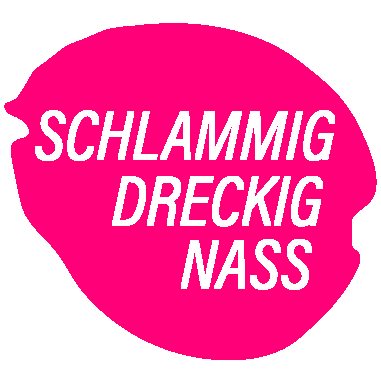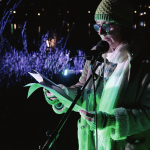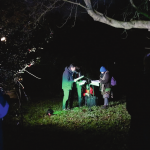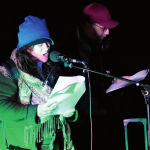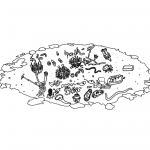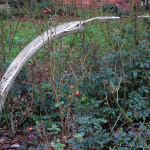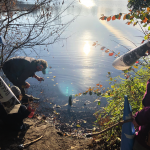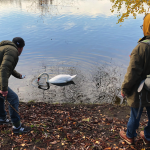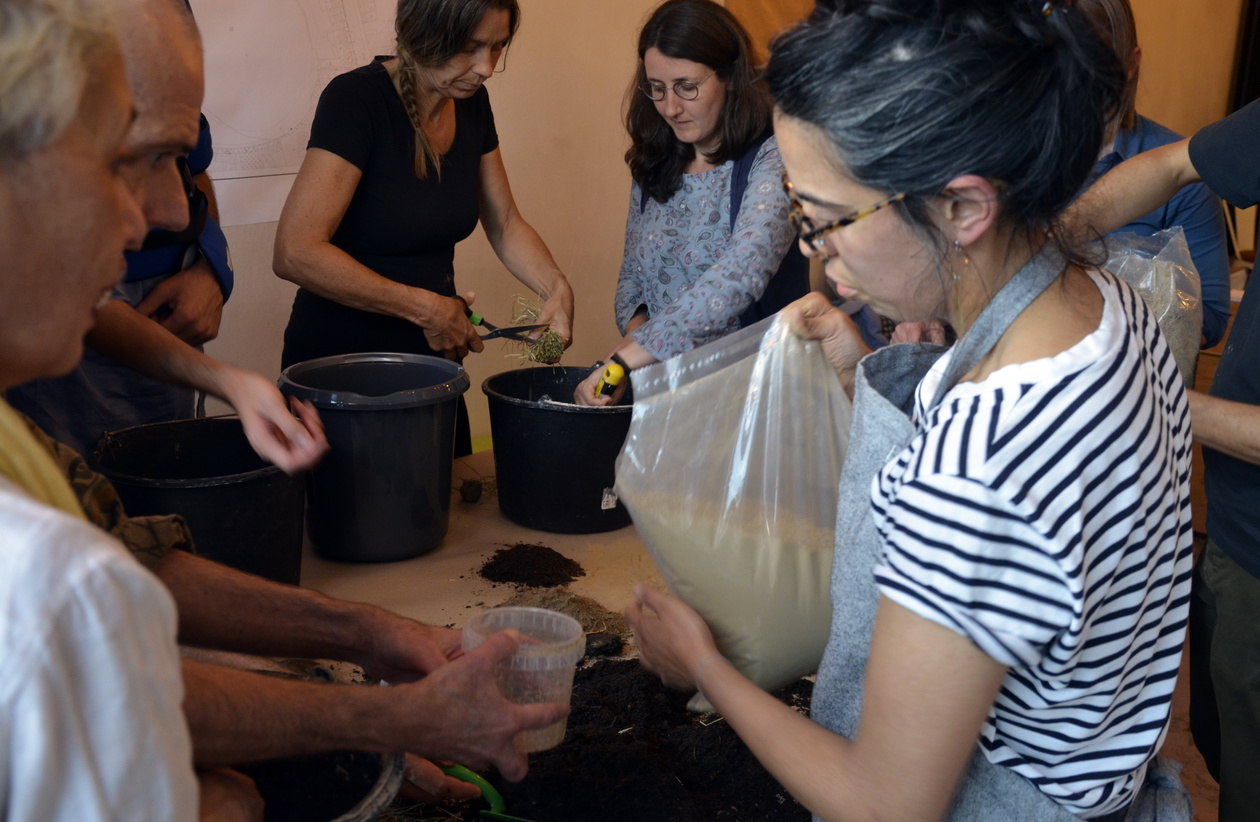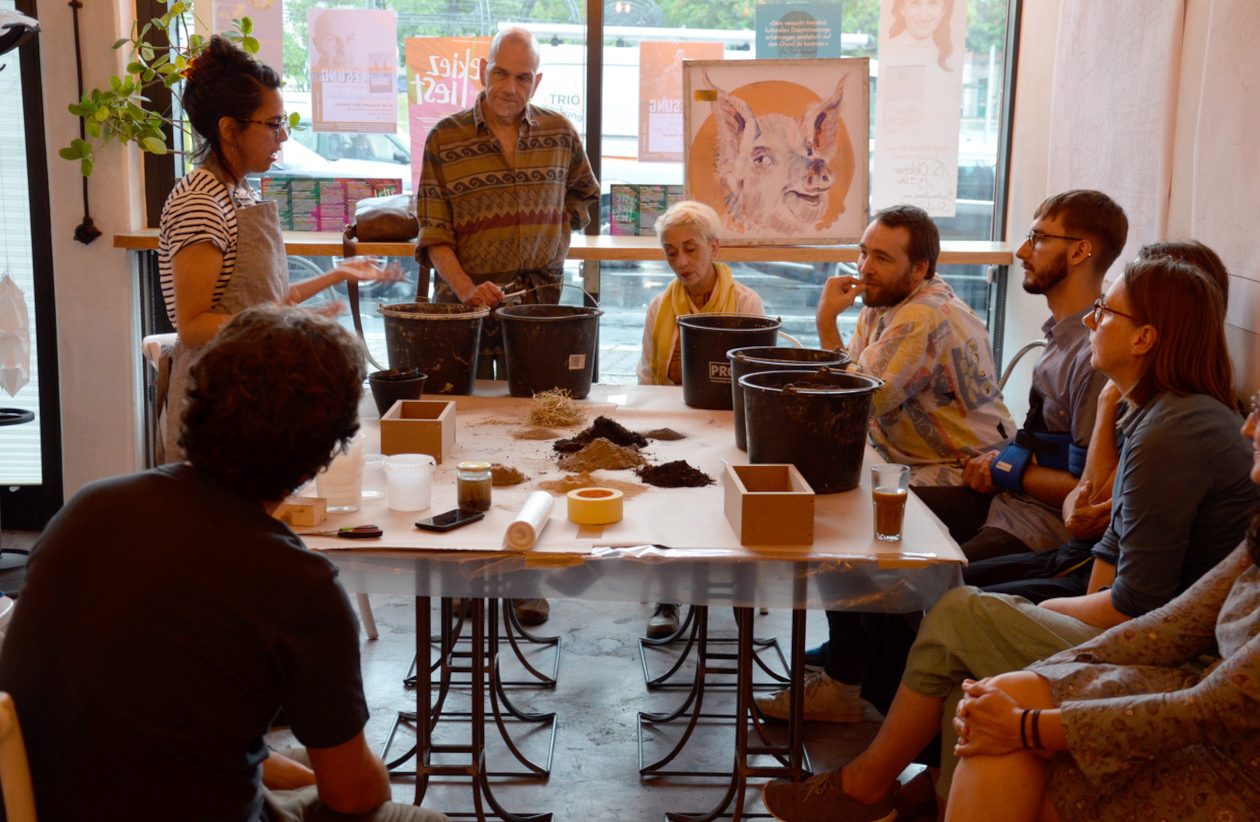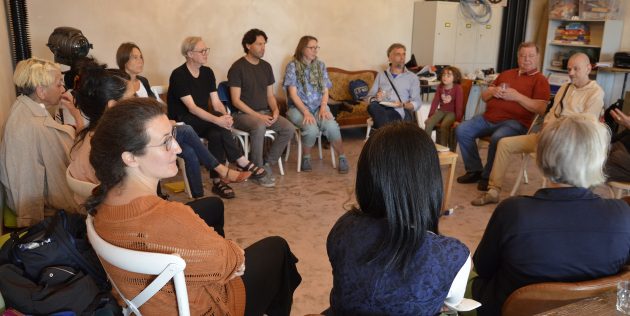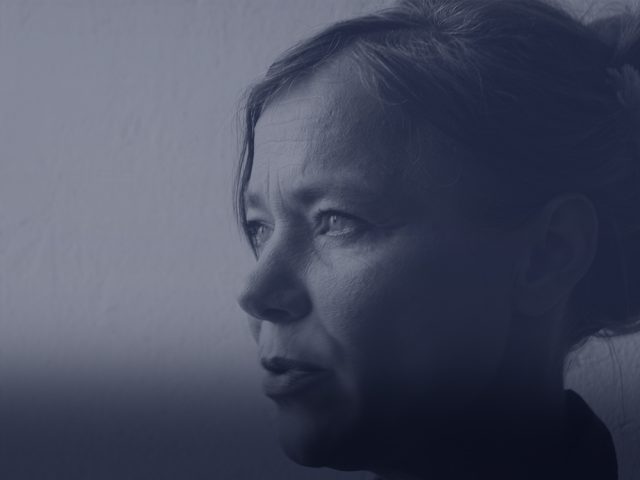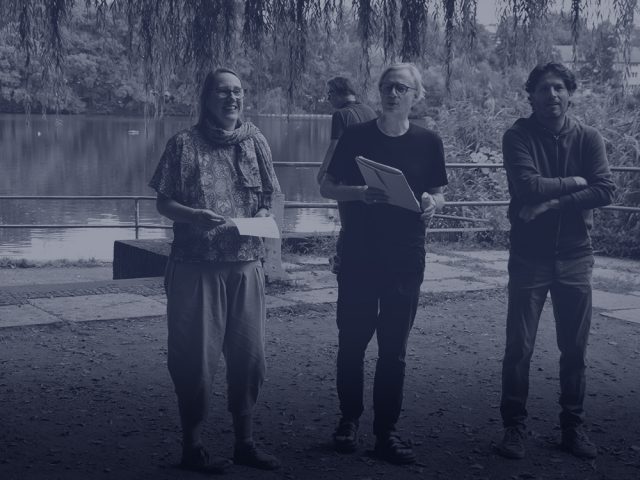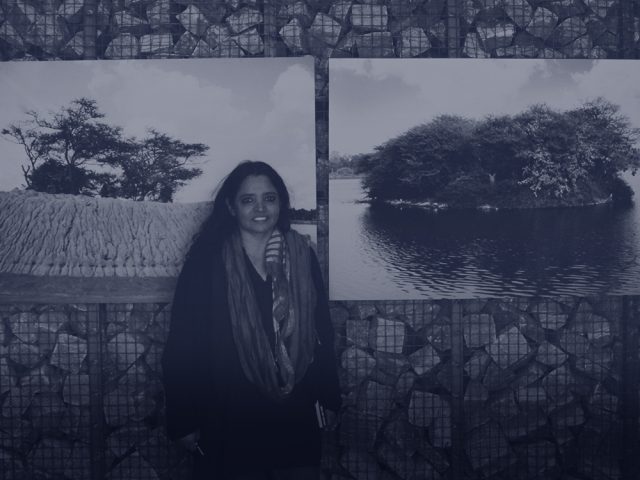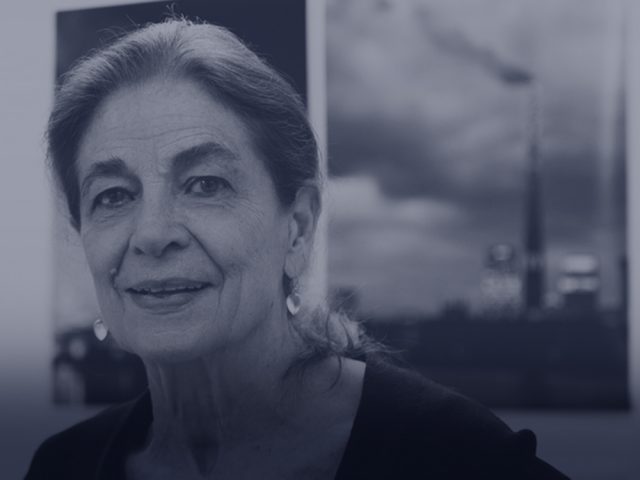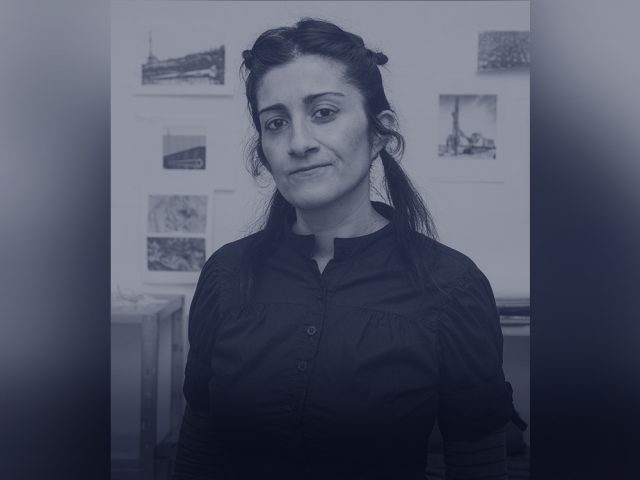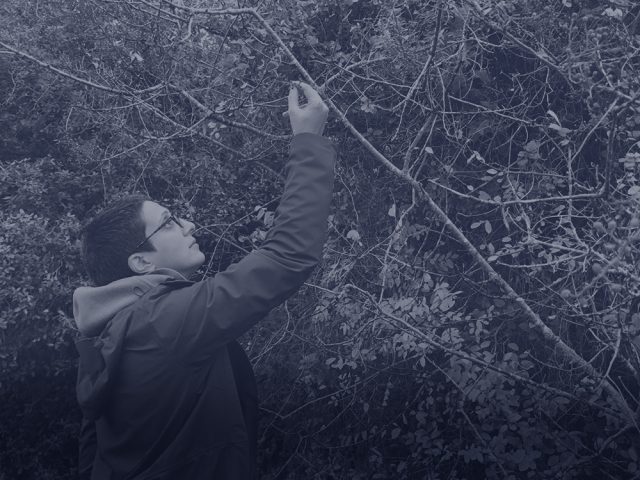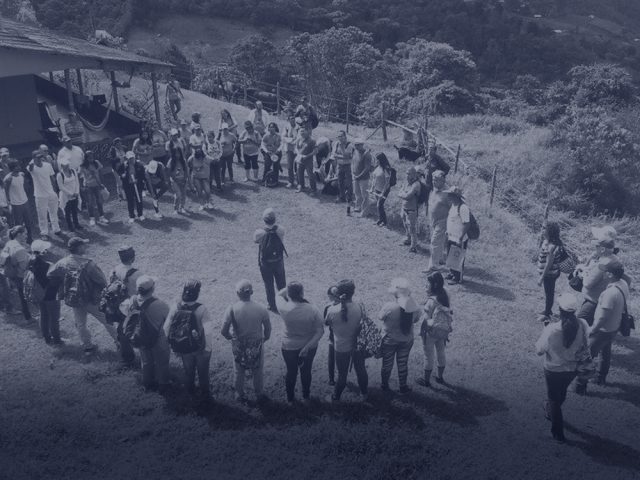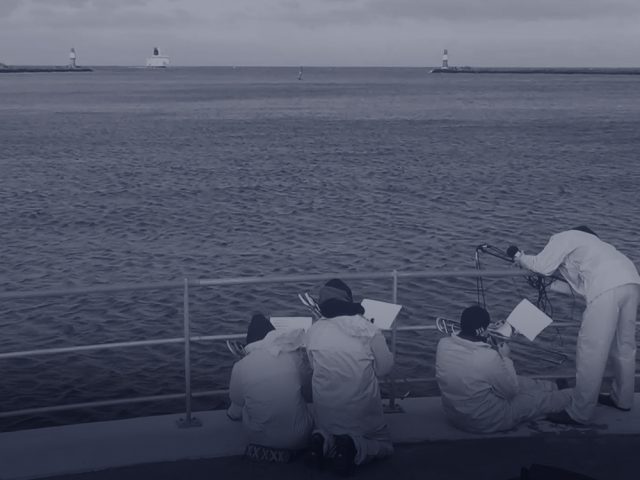Four temporary art interventions are being realized around the lake as an impulse for environmental education and as a concrete strengthening of environmental awareness. The approach is understood as an inspiration for a future “environmental education center”.
The roughly ten thousand year old lake Schäfersee in Berlin-Reinickendorf, measuring approximately 4.5 hectares, is used as a natural rainwater collecting basin. The formerly rich ecosystem of the lake has been severely damaged over the last century due to its integration into Berlin’s drainage network. The lake is 7 metres deep but is biologically dead from a depth of 2.5 metres, where around 70,000 cubic metres of toxic sludge are stored (increasing by 200 tonnes annually).
Currently there is no prospect of dealing with the expanding foreign substance. Can art help find a solution for coping with this issue? How can a digital platform make the extent of the underground sludge visible, and enable concrete participation? The contaminant in Schäfersee is still terra incognita in Berlin’s subsurface.
In view of the environmental problems of the lake, the participatory art project “Schlammig, Dreckig, Nass” was initiated to find alternatives for the conservation of the lake. The project has an interdisciplinary as well as a transnational character. Together with local and international actors (neighbours, artists, scientists) and initiatives, the remaining level of vitality and the possibilities for restoration of the lake were examined. The results of this discussion are conveyed in the form of artistic interventions and an art walk in the public space around the Schäfersee.
Participating artists: Andrea Acosta, Amuleto Manuela, Dorothee Quentin, Anja Schoeller, and Citizen Art Days (Oscar Ardila, Kerstin Polzin and Stefan Krüskemper)
SCHLAMMIG, DRECKIG, NASS was initiated by Citizen Art Days e.V. and was carried out in 2023 in cooperation with KiezMobil and Stadtteilzentrum Haus am See.
Download hier the full program
Intervention 1
SEEGESÄNGE
Partizipative, dialogische Lesungen an den Ufern des Schäfersees
Citizen Arts Days (Oscar Ardila, Kerstin Polzin und Stefan Krüskemper) mit Amuleto Manuela.
Der etwa 10.000 Jahre alte Schäfersee inspiriert dazu, über unser heutiges Verhältnis zur Natur und zum Wasser nachzudenken, seine Umwelt zu pflegen und seine Bedeutung für die Stadt zu erkennen. SEEGESÄNGE lud dazu ein, sich dem See durch Sprache und Klang zu nähern. Gemeinsam mit Interessierten vor Ort und internationalen Projektinitiativen (Kolumbien, Indien, Japan, Deutschland) wurden Texte, Gedichte und Tonaufnahmen mit Bezug zu diesem Ort entwickelt, um eine Hommage an den Schäfersee zu realisieren.
Entstanden ist ein Soundscape, der es ermöglicht, die Text- und Audiobeiträge mit den Klängen der Landschaft am Schäfersee zu verbinden. Am 07.01.2023 fand am See eine Performance statt, die die erarbeiteten Texte und Klänge im Austausch zwischen Lesungen und Klangkunst miteinander verknüpfte.
Das Ergebnis dieser Aufführung ist auf der dieser Publikation beigefügten Audio-CD zu hören.
Soundkünstlerin:
Amuleto Manuela
Autor:innen/Vorleser:innen:
Oscar Ardila, Heike Böttcher, Maestros del Agua, Johanna Dengler,
Sebastian Gräfe, Dagmar Krüskemper, Stefan Krüskemper, Henriette Löber,
Ayumi Matsuzaka, Marcela Moraga, Harald Polzin, Kerstin Polzin, Dorothee
Quentin, Anja Schoeller, Surekha Sharada
Quellenangabe:
> „Udine“ Aus der Publikation „Penthesilea & ich“ von Hanna Syriah, Selbstverlag, 2019
> Auszug aus der Geschichte „Akte: die Verwandlung“ aus der
Publikation „Ein Fluss, ein Archiv. Die Berliner Spree“ von Marcela
Moraga, 2022
> Auszug aus dem Song „Der seltsame See“ von Sebastian Gräfe, 2006.
Sound-Archives:
Victor C. Lewis – Bird sounds in close-up. // The sunken lighthouse a
sound composition by Marco Montiel-Soto & Misael Morales Vargas //
Lucrecia Dalt & Aaron Dilloway – Lucrecia Dalt & Aaron Dilloway.
Field Recordings in the forest of Colombia – 01 Lucrecia Dalt – In the
forest, transition between day and night. // Binaural Beat System –
Binaural Beats 2 Hz Deep Sleep. // Quantic, Nidia Gongora – Interludio
IV. // Lucrecia Dalt & Aaron Dilloway – Lucrecia Dalt & Aaron
Dilloway. Field Recordings in the forest of Colombia – 08 Aaron Dilloway
– In the forest, birds. // Jon Hassell – Caracas Night Semptember 11,
1975. // Sun Food – LeiLeiLah. // Huichaqueo Ñi Kuzaw – Spirit Women. //
Marcela Moraga – Agüita para el río // Maestros del Agua – Río Cali //
~pes: Pablo Torres Gómez & Elizabeth Gallon Droste – Brummen. //
Surekha – Listening to the lake. // Ayumi Matsuzaka – Japanese
Waterscape.
Für die Produktion dieser Audio-CD wurden von den am Projekt beteiligten Künstler:innen und Autor:innen Texte und Audioaufnahmen zur Verfügung gestellt, die Citizen Art Days e.V. für eine freie künstlerische Interpretation in Form eines Soundscape verwenden durften. Ebenso wurde das Sound-Archive für die freie Interpretation verwendet. Die Urheberrechte an den Originaltexten verbleiben bei den Autor:innen und Künstler:innen. Diese Audio-CD ist für nicht-kommerzielle Zwecke bestimmt.
© 2023 Citizen Art Days und die jeweiligen Autor:innen
Intervention 2
BEGEGNUNGEN MIT EINER UNSICHTBAREN LANDSCHAFT
Künstlerische Darstellung einer imaginären Landschaft mit Erde, Ton und Schlamm
Andrea Acosta
Was würden wir finden, wenn das gesamte Wasser des Schäfersees für
einen Moment entfernt würde und wir die unsichtbare Landschaft seines
Grundes sehen könnten?
Um uns eine mögliche Unterwasserlandschaft vorzustellen und ihr eine
Form zu geben, entstanden eine Reihe von Figuren aus Schlamm, Erde und
Ton die wir als künstlerische Intervention in der Umgebung des Sees
ausgestellt haben.
Intervention 3
BEWEGTER SOUND
Klänge rundum den Schäfersee
Dorothee Quentin mit Selbstgebaute Musik
Diese Intervention beschäftigte sich intensiv mit vorhandenen und
selbst generierten Geräuschen rundum den Schäfersee. In einem ersten
Schritt wurden Geräusche am Schäfersee auf einer Karte do- kumentiert
und interessante Objekte gesammelt, die sich als Klang- körper eignen.
Um neue Klangbilder zu kreieren wurde mit Hölzern, Steinen, Pflanzen und
dem Wasser des Schäfersees experimentiert.
Für das Neujahrskonzert wurde eine Soundroute zum Entdecken rund um den
See entwickelt und auf eine Karte verzeichnet. Die einzelnen Klänge
wurden performativ in einer Komposition zusammengeführt.
Intervention 4
UMSTÜLPKÖRPER ZUR SCHLAMMUMWÄLZUNG
Anja Schoeller
Das Oloid (auch Taumelkörper genannt), welches Paul Schatz Ende der 30iger Jahre entdeckte, ist ein geometrischer Körper der durch Um- stülpung aus dem Würfel entsteht. Er verkörpert das abstrakte Prinzip der Kräfte von Wasser in Bewegung, wie wir sie in Gewässern sowie in allen organischen Körpern finden. Als ein Werkzeug kann er trans- formatorische Prozesse auslösen und sichtbar machen. Das Oloid wird aufgrund seiner Wirbelbewegungen auch zur mechanischen Wasser- reinigung verwendet. Statt eines rotierenden Strudels hinterlässt ein montierter Oloid Wellenbewegungen die besonders zur Reinigung von Seen eingesetzt werden.
In Zusammenarbeit mit dem Tänzern Oliver Essigmann wurde eine Performance für den Schäfersee entwickelt, in der sich der Künstler mit seinem Körper tänzerisch den besonderen Eigenschaften und Möglichkeiten des Oloiden näherte.
Edition 2021/22
Workshops, International Conference and Program 2021
International conference on artistic strategies to support endangered waters
Watch the video of the conference in ENGLISH here.
Session 1 – The intersection of water, politics, economy, and art / Renaturation of nature
Session 2 – Political approaches
Mira acá el video de la conferencia en ESPAÑOL.
Sesión 1 – La intersección del agua, la política, la economía y el arte / Renaturalización de la naturaleza
Sesión 2 – Enfoques políticos
Project
In phase 1 of the project in September 2021, various content-related approaches to the problem took place in an artistic workshop with interested parties and experts. As a result, several artistic interventions were planned for the lake area. The interventions at the specific location are an opportunity to promote the networking of a local and global artistic community of actors who develop and implement innovative action models to improve the situation of the waterways in the city.
In phase 2 of the project in February 2022, a digital conference presents networks and international art projects that deal with the protection of threatened waters. With which artistic strategies and in which form of collaboration do the different project groups work? What problems and difficulties do we encounter internationally? And what contribution can art make to the ecological protection of waters?
The project was initiated by Citizen Art Days e. V. (Oscar Ardila, Stefan Krüskemper, Kerstin Polzin), an association providing a platform that brings citizens, artists and urban actors together in order to address specific common problems using artistic strategies.
Citizens’ initiative
During the first phase of Schalmig, Dreckig, Nass we worked together with the Schäfersee project group, which is an important actor that has addressed the environmental issues of the lake. The Schäfersee project group was formed in April 2016 and consists of NABU (Nature and Biodiversity Conservation Union Germany) members and residents of the Schäfersee. The aim of the group is consistent nature conservation and protecting the lake from toxic street sewage.
Workshop
SCHLAMMIG DRECKIG NASS is a multi-day workshop towards a political artistic culture, incorporating on-site actions to create participatory formats for restoring endangered urban biospheres. During three days in September 2021, some workshops on Lake Schäfersee were held. Site specific interventions were sketched in order to provide occasions to facilitate a network between local and global artistic communities and actors. These researched and developed strategies of implementing innovative action models to improve the condition of the city’s waters.
Description
The workshop SCHLAMMIG DRECKIG NASS took place from September 9th-21st 2021 at the Projektraum M5 and around the Schäfersee in Berlin-Reinickendorf. Interested members of the public and experts explored various approaches to the problems pertaining to the lake’s sensitive ecosystem, as well as its living and recreational space. Ideas emerged for art events in the public space of the park, as well as interventions for the lake. Parting from the idea of human influence on nature, several representations were designed in the form of action models, as approaches or concrete activities. The models form the basis for the realisation of future life, representing the renaturation of the lake.
Report
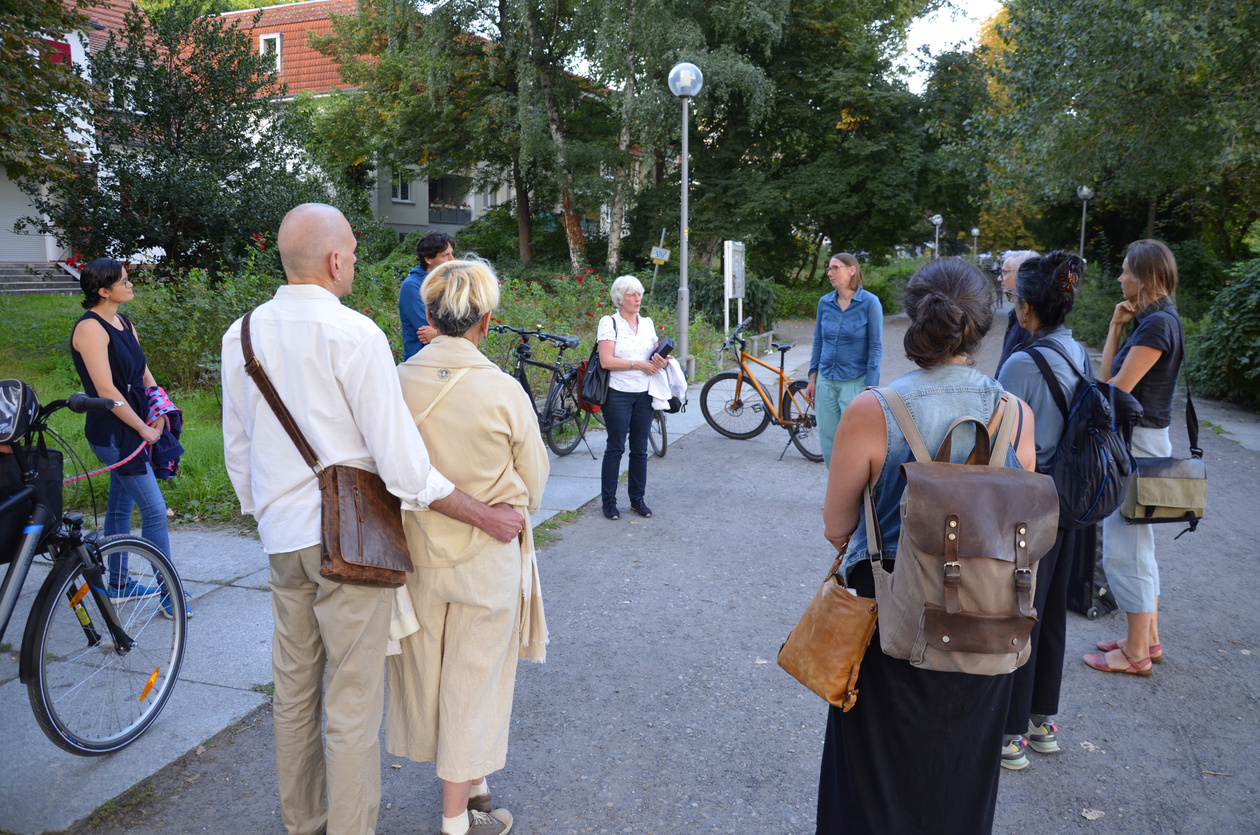
At the beginning on Thursday, September 9th, 2021, the working meeting started with a walk around the Schäfersee. The starting point was the promenade at the family and district center “Haus am See”
Carmen Schiemann – The director of the Initiative Schäfersee e.V. reported about the change of everyday life in the park over the last hundred years, during wartime, and the increasing changes due to the increasing use of green areas by park visitors, as well as the progressive loss of flora and fauna.
Workshop with Andrea Acosta (born in Bogotá, lives and works in Berlin. Her interdisciplinary work combines field research with sculpture, photography and drawing. In a process-based practice, she examines established ideas of nature and landscape and their relationship to constructed spaces. In doing so, she reflects the constant transformation of matter, gaze and territories.)
On Friday, participants presented their specific artistic research approaches. Afterwards, a BWB (Berlin Water Company) staff member gave a presentation, followed by a discussion with the BWB’s press officer on the condition of the Schäfersee’s inlet and outlet pipes, and comprehensive planning as part of a development concept for the water bodies in the mixed sewage zone of Berlin. Andrea Acosta taught producing clay bricks using mud from Schäfersee. Anja Schoeller invited participants to a council meeting.
Saturday provided space for a design thinking process facilitated by Dorothee Quentin. A number of ideas emerged that could permanently change the relationship with the lake. In his presentation, biologist Juan Pablo Díaz showed how the smallest living organisms of the lake can be made visible under the microscope, the significance they have for water quality, as well as the possibilities of using flora and fauna as multipliers. At the end of the design thinking process, three areas of focus emerged from the ideas and action models: healing and purification of the space, performative interventions to explore spaces, as well as new perspectives inside and around the lake, and finally relaxation and recreation in the context of artistic happenings.
On Sunday, Anton Kulmus and Emil Nolde, who have been involved in activities for the Schäfersee for a long time, joined a brunch which offered room for exchanging the outcomes thus far. This was followed by a political discussion, where information gathered in the workshop was leading to a joint conclusion. Around noon, numerous guests arrived for the Artwalk, where the interim results of the workshop were presented to a broader public during a tour around the lake. Finally, everyone was invited to a closing round in the M5 project room.
Artist interviews
Videos coming soon
Artwalk
Photo and documentation
Participants Phase 1
Conference
MUDDY, DIRTY, WET
International conference on artistic strategies to support endangered waters
February 12th and 13th 2022
In February 2022, a digital conference presents and networks international art projects that deal with the protection of threatened waters. Around three central themes, questions will be addressed such as: With which artistic strategies and in which form of collaboration do the different project groups work? What problems and difficulties do we encounter internationally? And what contribution can art make to the ecological protection of waters?
Topics:
The intersection of water, politics, economy and art.
In many places the alarming impression arises that the growing dynamic
of strain on natural cycles faces stagnating planning policies paired
with economic exploitation of sources (waters, soil, income from water
usage). Citizens are excluded from the decision-making process.
Citizens’ initiatives, activists and environmental associations are not
included in the processes of participation. Tried and tested pioneer
projects end up in drawers, and old structures of urban water management
erode without meaningful realisation of already thought-out, discussed
and promised paradigm changes. Individual examples repeatedly make
evident that alerting the public in connection with artistic projects
increases the pressure on the decision-making organs, setting renewal
processes in motion. It is therefore vital to strengthen the role of
democratic creative participatory processes to innovatively rethink
coexistence in the city. All residents and living beings inhabiting
natural and urban spaces should be able to experience these as their own
in a positive sense. Crises need to be overcome by finding and
implementing joint solutions.
Renaturation of nature.
We often have an inaccurate idea of how our cities’ water bodies
function, and how they should be cared for. In a park – designed to be a
perfectly crafted garden with trees, fountains and swans – it is very
easy to confuse the almost idyllic experience of standing by a river or
lake with an intervention in balance with the ecosystem. Beneath the
surface of the water we do not see the effects of pollution and
large-scale water mismanagement, such as immense layers of toxic sludge
developing, and bodies of water shrinking. For this reason, some artists
and communities globally have taken it upon themselves to raise these
invisible aspects to the surface. They personalise and reinterpret the
way we see our relationship with nature. They have reflected on
landscape as a cultural construct, and have outlined alternative
sustainable, appropriate and reciprocal relationships with nature. The
restoration of nature consists then in making us aware of the purely
ecological aspects in accordance with the purely aesthetic experiences
of bodies of water.
Political approaches
Projects with a political focus and artistic strategies rely on the
achievement of specific goals. The exciting interplay of both artistic
and political-activism strategies, provides potential for new
approaches. Activism and art merge in a common goal. But from a global
perspective, political action in some regions of the world implies great
dangers for artists. In this context, numerous new forms of
organisation and expression have emerged. The natural world’s rights, or
demands for the abolition of unjust laws are possible topics.
Session 1
Saturday February 12th
Berlin, Germany
Berlin, Germany
IF YOU WANT TO THE SOURCE, YOU HAVE TO SWIM AGAINST THE CURRENT
Montreal, Canada
Theme 1 – The intersection of water, politics, economy, and art
Topics:
- Administrative apparatus and politics
- Water as a profit earner despite growing pressure on ecosystems
- Citizenship, public, making visible a political effect
- Tensions between political theory and practice
Bangalore, India
Tokyo, Japan
Option to continue the conversation in a breakout room in Zoom
Theme 2 – Renaturation of nature
Topics:
- Romantic image of nature and the trauma of the climate crisis
- Art projects that open up spaces of experience and convey the importance of issues around water
New York / Milwaukee, USA
Renaico River, Chile
Option to continue the conversation in a breakout room in Zoom
Warnow, Germany
Session 2
Sunday February 13th
Theme 3 — Political approaches
Topics:
- Rivers have rights
Ramallah, Palestine
Janis Stefania Ordoñez, Kelly Vanessa Suarez, Hernando Díez, Mauricio Lara
Cali, Colombia
Option to continue the conversation in a breakout room in Zoom
Berlin, Germany
Simultaneous interpretation into English, Spanish and German
Free registration at: info@citizenartdays.de
Download the program as PDF
Talks review
MUDDY, DIRTY, WET
International conference on artistic strategies to support endangered waters
SCHLAMMIG, DRECKIG, NASS (MUDDY, DIRTY, WET)
Participants of the Project
Berlin – Germany
12th February at 14.40 CET – Berlin Time
The participants of the project present some reflections on the issue of environmental management around the Schäfersee Lake. On this occasion the joint work between citizens and artists has opened up other possibilities for political and civic action in this part of the city of Berlin.
IF YOU WANT TO THE SOURCE, YOU HAVE TO SWIM AGAINST THE CURRENT
Prof. Dr. Rafael Ziegler HEC Montreal
Montreal, Canada
12th February at 15.00 CET – Berlin Time
In his book ” If you want to the source, you have to swim against the current “(2017), Rafael Ziegler, philosopher and economist, tells the story of a decades-long resistance of citizens getting organized in their resistance against the construction of a dam in a valley in the Spessart and for the preservation of water in local, communal hands. The regeneration of watershed aims at a self-determined preservation of land and water. It is a piece of recent democratic history with many lessons for water protection in the present.
LAKE TALES: NEGOTIATING THE URBAN RURAL MARGINS.
Surekha
Bangalore, India
12th February at 16.00 CET – Berlin Time
Surekha’s presentation is about two lake projects – a rejuvenated Jakkur Lake & the polluted lake on fire, Bellandur Lake, situated in Bangalore (India). These projects are compiled through documentation, performance, archives and involves the community participation of artistic/social kind; and relates to urban-ecological climatic issues of a wider spectrum (http://surekha.info/negotiating-routes-jakkurlake/)
MYMIZU – THE ENTERPRENEUR AS AN ARTIST
Ayumi Matsuzaka, Robin Takashi Lewis
Tokyo – Japan
12th February at 16.20 CET – Berlin Time
The presentation by Robin Lewis, founder of Mymizu, and Ayumi Matsuzaka, co-founder of Dycle, will explore the extent to which entrepreneurs can use artistic strategies to protect the environment. Robin Lewis writes about his work that the company is co-creating tools and community. Ayumi Matsuzaka will speak about social entrepreneurship from a theoretical perspective.
WATERMARKS: AN ATLAS OF WATER FOR THE CITY OF MILWAUKEE
Mary Miss
New York / Milwaukee
12th February at 17.30 CET – Berlin Time
WaterMarks is an initiative to develop an inclusive and urban-scaled vision for the city of Milwaukee to help residents better understand their relationship to the water systems and infrastructure that support their lives. It is an art based multi layered framework to engage people in communities throughout the city. To start the process of engagement we pair artists with scientists / other experts to organize walks within the communities where we work. These walks encourage local residents and stakeholders to consider the social and ecological challenges they face and how these challenges can be overcome.
WE WILL WIN, THE RIVER TOLD ME
Marcela Moraga & Colectivo Social Salvemos el Río Renaico
Renaico River, Chile
12th February at 17.50 CET – Berlin Time
Renaico in Mapudungun, the Mapuche language, means a place where a lot of water flows. The Renaico River once provided trout and carp, it was the site of personal and collective memories. Why is the river drying up? Is the history of the community disappearing along with the water? The Museo Comunitario del agua Río Renaico proposes through different artistic actions to establish a new dialogue between a town and its river.
WASSERMUSIK SUITE NO.2
Composition for a river’s glorious welcome to the sea.
Sebastian Gräfe & Matthias Kranebitter
Warnow, Germany
12th February at 18.30 CET – Berlin Time
When it arrives in the sea, the river has reached both its maximum size and final stage. To mark the occasion, a brass band plays a piece, written especially for the river, at its mouth, paying it a special tribute. The musical aesthetic qualities of flowing waters feed into the composition, and the sound is led directly into the water. The piece does not portray the river, nor is it a simple homage; but rather, the work is translated back into the language of the river.
RESILIENCE – FROM SHRINES TO BULLDOZERS
Sahar Qawasmi (Sakiya Art Science Agriculture Initiative)
Ramallah, Palestine
13th February at 14.00 CET – Berlin Time
In her presentation Sahar will speak about contemporary realities of
natural, traditional, and social systems and infrastructures with a
focus on water, and Sakiya’s approach for their protection,
regeneration, and reimagination.
Sakiya – Art | Science | Agriculture is a progressive academy, a field
for experimental pedagogy situated on a rewilded hillside with historic
buildings, ancient trees, and natural springs in the village of Ein
Qiniya near Ramallah in Palestine. Sakiya’s practices reclaim a wider
ecology of knowledge through de-learning, relearning, and learning from
and with the land and each other towards self-sufficient futures.
Sakiya’s model integrates the forest and the farm within a
cross-disciplinary residency program grafting local agrarian traditions
with contemporary art and ecological practices.
FOR COMMUNITY WATER MANAGEMENT
Meastrxs del Agua (Teachers of water)
Cali, Colombia
13th February at 14.20 CET – Berlin Time
This school has sought to awaken environmental awareness and strengthen the culture of water from the empowerment of communities living around the city of Cali-Colombia, care for and inhabit the territories of water. We focus on Community Aqueducts and Community Water Governance, seeking, among others, to ensure the supply of drinking water and conserve local watersheds.
Links
Speakers and Moderation
About Us
SCHLAMMIG, DRECKIG, NASS is organised by Citizen Art Days e.V., an association of artists based in Berlin. Since 2012 Citizen Art Days has offered an artistic platform that brings together citizens, artists and city actors to solve specific problems in public spaces using artistic strategies. The themes are post-growth economy, sustainability, and coexistence. The aim is the joint development and participatory shaping of ideal (artistic) spaces that offer ample opportunities for experimentation and design for all involved.
Team
Konzept und Projektleitung
Citizen Art Days – Oscar Ardila, Stefan Krüskemper, Kerstin Polzin
Teilnehmende Künstler:innen
Andrea Acosta, Oscar Ardila, Oliver Essigmann, Stefan Krüskemper, Amuleto
Manuela, Kerstin Polzin, Dorothee Quentin, Selbstgebaute Musik, Anja Schoeller
Referent:innen
Citizen Art Days, Maestros del Agua (Janis Stefania Ordoñez, Kelly Vanessa Suarez,
Hernando Díez, Mauricio Lara) Sebastian Gräfe & Matthias Kranebitter, Ayumi
Matsuzaka & Robin Takashi Lewis, Mary Miss, Marcela Moraga & Colectivo
Social Salvemos el Río Renaico, Sahar Qawasmi, Wolfgang Runge, Projektgruppe
Schäfersee, Surekha Sharada, TIER, Prof. Dr. Rafael Ziegler (HEC Montreal)
Social Media Management
Lorena Díez
Grafik
Anselm Polzin, Andrés Sandoval, Michaela Nasoetion
Fotodokumentation
Lorena Díez, Stefan Krüskemper, Anselm Polzin, Harald Polzin, Kerstin Polzin
Videodokumentation
Gisela Zárate Tobón
Web Design
Davide Prati
Übersetzung
Leonore Lukschy
Künstlerische Assistenz
Sara Alvarado, Lorena Díez, Simone Fischer
Kooperationspartner:innen
KiezMobil, Projektgruppe Schäfersee, Stadtteilzentrum Haus am See,
Stiftung Dialog und Soziale Gesundheit
Dank an:
Adem Erenci und Johanna Klinkenbusch (KiezMobil), Melanie Stiewe
(Projektraum M5)
Sponsors
The project SCHLAMMIG, DRECKIG, NASS by Citizen Art Days (Oscar Ardila, Stefan Krüskemper, Kerstin Polzin) is part of the initiative DRAUSSENSTADT, funded by the Berlin Project Fund Urban Practice and the Senate Department for Culture and Europe.

Website and Social Media
Instagram: @citizenartdays
Facebook: https://www.facebook.com/citizenartdays
More info at www.citizenartdays.de
